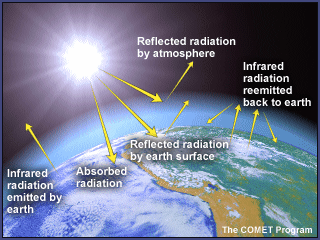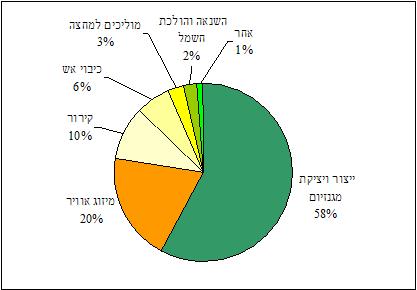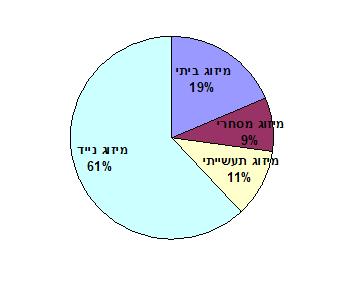The Central Bureau of Statistics published the greenhouse gas emissions data for 2008 which amounted to 78 million tons of CO2. The focus is on ingredients that are easy to control and whose impact on the greenhouse is higher than MPD

New in CBS: Emission data of fluorinated greenhouse gases: 2008 Inventory of Fluorinated Greenhouse Gases 2008
One of the phenomena accompanying the technological and industrial development and the increase in the standard of living is the increased emission of greenhouse gases into the atmosphere. An increase in the concentrations of greenhouse gases in the atmosphere causes an increase in the earth's temperature and significant climate changes on a global scale. Many countries have united to act around a common goal of reducing man-made greenhouse gas emissions. As part of this action, the UN Climate Convention (UNFCCC, Rio de Janeiro, 1992) and the Kyoto Protocol (1999) were signed. The State of Israel signed and ratified the above agreements but was not obligated at this stage to reduce emissions. However, Israel was asked to periodically report its emissions inventory to the UN Climate Convention Secretariat. The State of Israel also signed and ratified the Montreal Protocol (1992) - an international treaty that came to protect the ozone layer from harm, by imposing restrictions on the production and consumption of gases that endanger it from the groups of CFCs and halons (bromo-fluoro-hydrocarbons). These gases are gradually being replaced in the world, among other things, by several greenhouse gases that contain fluorine.

These days, the Central Bureau of Statistics (CBS) is publishing, for the first time, the data on greenhouse gas emissions containing fluorine (HFCs, PFCs, SF6 - this group of gases is used for the production and operation of various types of products and systems. So far, the greenhouse gas emissions data included, published by the CBS, emissions of the three main greenhouse gases: carbon dioxide (CO2), methane (CH4) and nitrogen dioxide (N2O), which accounted for 85.3%, 8.8% and 3.6% respectively of the total greenhouse gas emissions In Israel in 2008. In addition, the data included greenhouse gases that participate in the formation of ozone (CO, NOX, NMVOCs) and the formation of aerosols (SO2). The data on the greenhouse gases that contain fluorine complements the data on Israel's greenhouse gas emissions.
Despite the relatively modest contribution of these gases to the total greenhouse gas emissions in Israel (about 2.3%), the potential for reducing the emissions of these gases is high and their effect on increasing the greenhouse effect is great and ranges from 140 to 23,900 times that of the most common greenhouse gas - CO2, depending on the type of gas .
The emissions of these gases occur in production processes in which the gases are involved and during the use and disposal of products or systems containing the gases. HFCs, PFCs, and SF6 are not produced in Israel but are imported as gases or as products containing the gases. The emissions calculations are based on the quantities of gases imported to Israel, their distribution among consumers and among the various uses and the emission coefficients for each use.
There are seven main emission sources: production and use of cooling systems, production and use of air conditioning systems, production and use of fire extinguishing systems, production of semiconductors, production and use of systems for heating and switching electricity, production and casting of magnesium and use of medical inhalers. The calculation does not refer to emissions that occur during the disposal of systems containing the aforementioned gases (except for vehicles), to continuous emissions that began before the reporting year, and to emissions as a result of the use of sprays, sealants and industrial cleaning agents.
Table 1- Gas emissions cruises by types and sources (equivalent to one thousand tons of CO2)

The emission sources of the greenhouse gases containing fluorine
Magnesium production and casting - 58% of emissions
In Israel there are several factories engaged in the production and casting of magnesium. These factories use the greenhouse gases SF6 and HFC-134a in the production and casting processes, where 90% and 50%, respectively, of the gas quantities consumed are emitted.
Air conditioning systems - 20% of emissions
The use of HFCs in air conditioning systems is very common and is an almost exclusive replacement for gases from the CFC group, which cause the thinning of the ozone layer and whose use will be completely stopped in 2020 as a result of the implementation of the Montreal Convention. The air conditioning category consists of four sub-categories:
A. Home air conditioning
B. Commercial air conditioning
third. Industrial air conditioning
d. Air conditioning/mobile cooling (air conditioning in vehicles and refrigerated vehicles)

Cooling systems - 10% of emissions
The use of gases from the HFCs group as cooling gases in cooling systems is also common as an almost exclusive replacement for gases from the CFCs group. The cooling category consists of 3 sub-categories:
A. Home cooling - home refrigerators up to a volume of about 750 liters.
B. Commercial refrigeration - refrigerators found in food marketing chains, restaurants, grocery stores, etc.
third. Industrial refrigeration - refrigerators used by food manufacturers, cold rooms, wholesale food storage centers, etc.
Diagram 3 – Distribution of emissions from cooling systems
Stationary fire extinguishing systems - 6% of emissions
Stationary fire extinguishing systems use HFCs and PFCs as an alternative to gases from the group of halons that damage the ozone layer.
Semiconductors and electronics - 3% of emissions
The semiconductor manufacturing industry is an almost exclusive source of PFCs emissions, as the gases are used for several processes in this industry. Out of all the applications, it is possible to locate two main applications where most of the emissions occur: Plasma Etching and a cleaning process using Chemical Vapor Deposition technologies.
Electrical heating and switching systems - 2% of emissions
In Israel, the heating and switching systems that use the SF6 gas as an insulating medium are installed. These systems contain this gas in quantities ranging from tens of kg to hundreds of kg per system.
MDI type medical inhalers - 1% of emissions
One of the common treatments for respiratory diseases in Israel is an MDI (Metered Dose Inhaler) inhaler. This preparation releases a medical suspension using propellant gas (from the HFCs group) directly into the patient's lungs. The existing propellant gases replaced the gases from the CFCs group as a result of the implementation of the Montreal Convention.
International comparison
The proportion of greenhouse gases containing fluorine in the total emissions of greenhouse gases in Israel (2.3%) is similar to their proportion in developed countries in the world: 2.5% in the USA, 2% in Japan and 1.8% in Germany.
In conclusion
- The total emissions of greenhouse gases containing fluorine in 2008 were 1,821 thousand tons of CO equivalent2.
- The amount of emissions constitutes about 2.3% of Israel's total greenhouse gas emissions (which stood at 78 million tons in 2008) out of this amount:
-
- 62% was emitted as a result of magnesium production and casting processes
- 30% was emitted as a result of the production and use of cooling and air conditioning systems
- 8% was emitted as a result of semiconductor production and other uses
- As a result of the implementation of the Montreal Convention, gases from the groups of CFCs and halons, which harm the ozone layer, were replaced by a number of greenhouse gases containing fluorine (about 37% of total emissions).
- The proportion of greenhouse gas emissions containing fluorine out of the total greenhouse gas emissions in Israel is similar to their proportion in other developed countries.

9 תגובות
Upon re-examination - it turns out that "potato" is probably an urban legend, so I change the word to "Oznit, Oznit Telfon"
Strong:
I didn't know that the academy decided that.
It is interesting.
However - I still think this is a wrong and misleading translation.
By the way, I assume you don't use the word "potato" either.
Michael:
Language is a dynamic thing, it changes all the time, there are changes that cause it to erode and some that cause it to be enriched. In many cases, incorrect expressions are indeed invented, but not every innovation is bad.
And regarding the terms in chemistry: the standard form of simple compounds in chemistry is noun and adjective, as in the examples I gave earlier. This is also what the Academy of Language stated, from its website: tishmozat [the adjective acidic is used in the names of the oxides: sodium oxide, carbon dioxide].
That is, the word oxide is used for a general description of a compound of some element with oxygen, but the names of the oxides are according to the structure of a noun and an adjective.
It's normal, it's reasonable, it allows for uniformity and makes it possible to give names to more compounds.
The connection to the word "publicity" is particularly strong.
The use of the word "archaic" highlights this well.
We have had people for whom the correct translation of the phrase in English no longer seems "sound" enough, so they invented another phrase and made the correct phrase archaic.
Strong:
Indeed, Hebrew is getting more and more wrong.
The word "finish" has also lost its original meaning.
The word public was also born as a swelling of the word public.
See the words of Prof. Amram Eshel in the link in response 3.
http://www.bashaar.org.il/Question.asp?Question_id=3208
The accepted term today is carbon dioxide. The term carbon dioxide is an archaic term.
So is sodium chloride, calcium carbonate, sulfur dioxide and much more.
Someone else entirely:
The more correct term is carbon dioxide because the phrase "carbon dioxide" may make the reader think that it is a special type of carbon that is dioxide when it is a compound in which one of the components is completely normal carbon.
DTP - carbon dioxide? It would have been better
To use the more correct term: carbon
Dioxide.